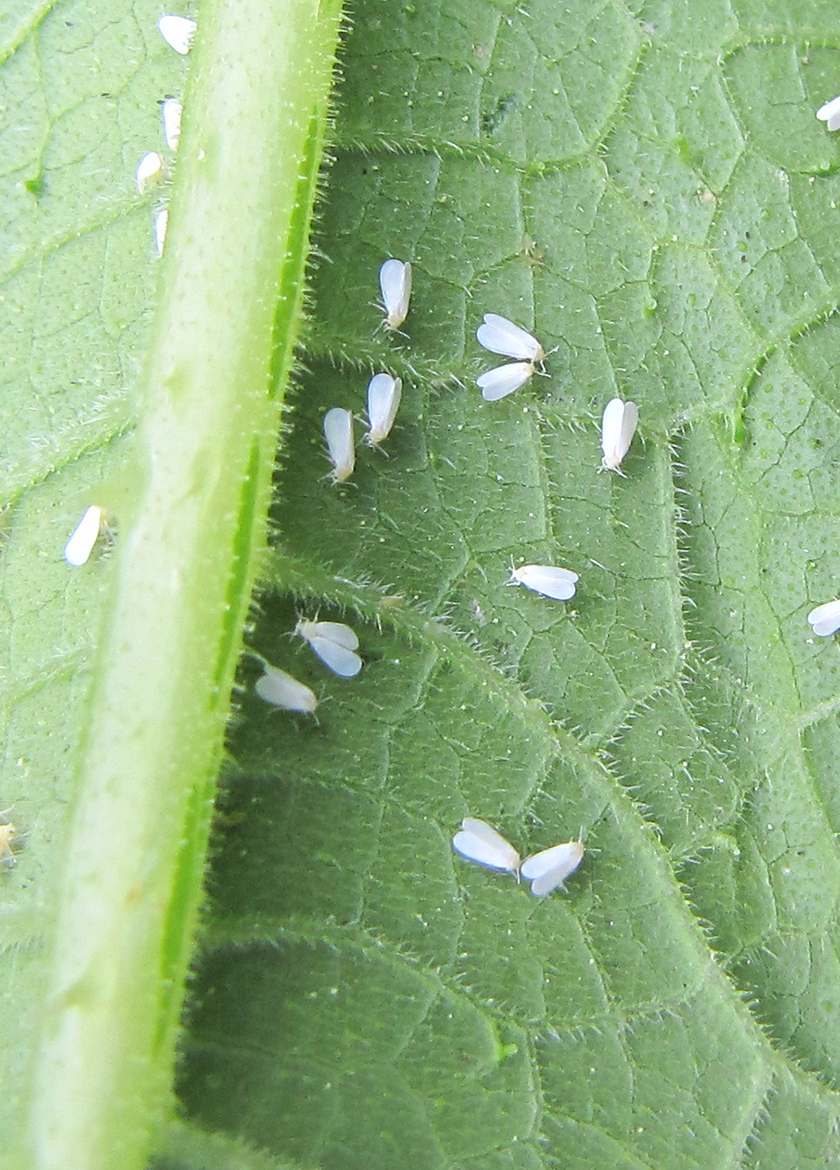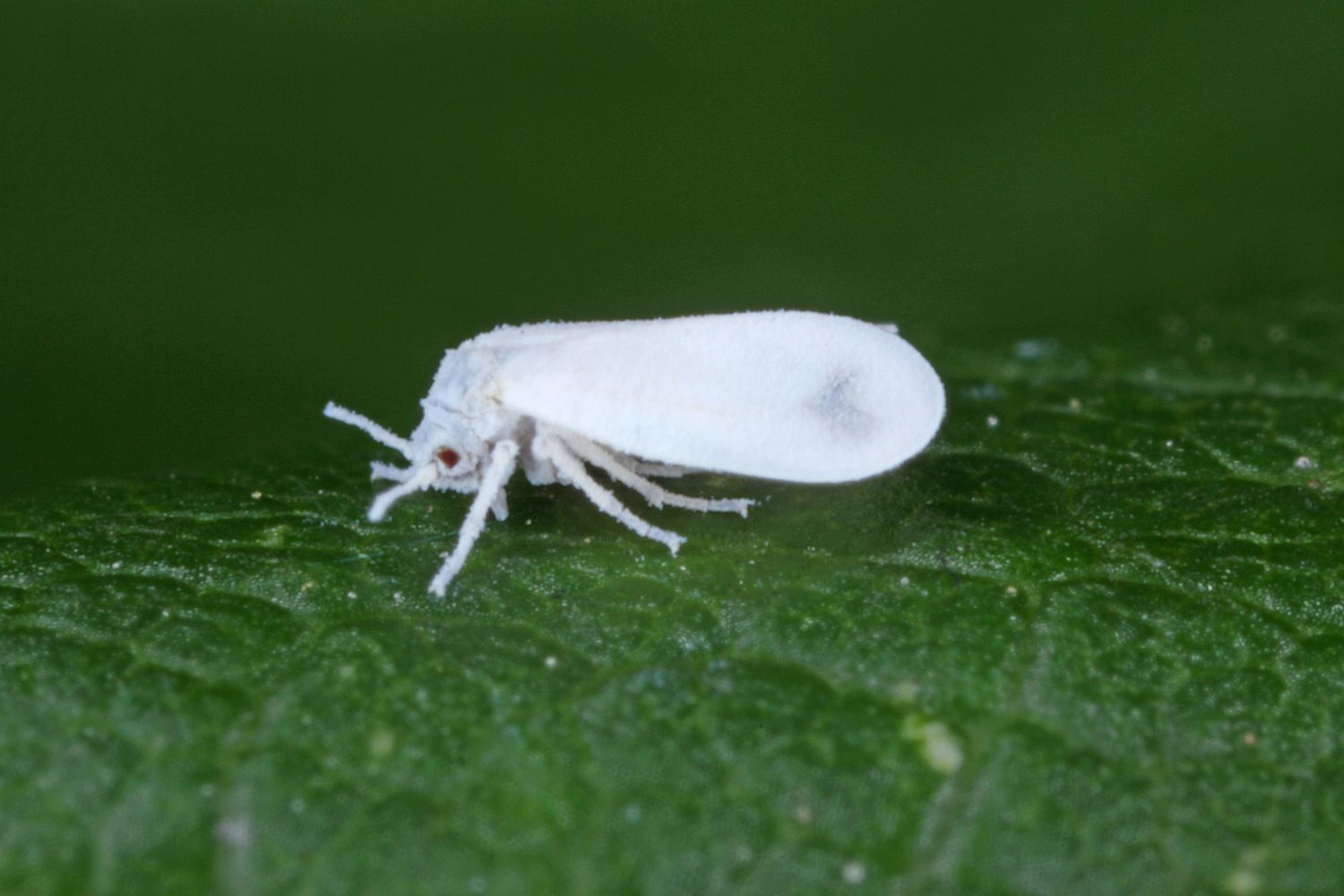
Similar to aphids, whiteflies can be a real headache in the garden. These tiny, light-colored pests flutter around, sipping on plant juices and carrying diseases. What’s more, they’re so small that they can slip through various mesh screens, making them a big issue in greenhouses and indoor growing areas.
But don’t worry, there are ways to kick these little white insects out of your greenhouse or garden. Let’s discuss whiteflies, their breeding habits, and effective ways to bid them farewell!
Understanding Whiteflies
Physical Characteristics of Whiteflies
Picture this: you’re in your garden, and you notice these tiny, winged creatures fluttering around your plants. Those might just be whiteflies. These minuscule insects, usually no larger than 1/16th of an inch, have a distinctive appearance. Take a closer look, and you’ll see they have a white, waxy coating that covers their wings and body. When disturbed, they tend to flutter away in a cloud-like formation.
What sets whiteflies apart is their knack for blending in with the undersides of leaves. Sneaky, right? Keep an eye out for these pale, almost-translucent pests, and you’ll be one step closer to identifying them.
Life Cycles of Whiteflies
In late spring, adult whiteflies carefully lay their eggs on the undersides of leaves, forming neat concentric patterns, mostly toward the upper part of the plant. A single adult whitefly can lay a significant number of eggs, ranging from 200 to 400.
Around five to ten days later, the whitefly eggs transform into nymphs. During the initial stage, known as the crawler phase, the nymphs move a short distance away from their eggs and then flatten against the leaf to feed. Although there are four instars in total, once the crawler settles in its chosen spot, it stays there for the remaining instars.
Identifying these nymphal stages can be tricky. Once they stop crawling and attach to the leaf, they often resemble scale insects. Their color blends with the leaf they’re on or is slightly lighter.
Following the nymphal stages, the whitefly larva enters the pupal stage. Within about a week, the whitefly emerges from its old skin as a new adult, ready to initiate its own egg-laying cycle. These small, white flying insects can live for a couple of months as adults before reaching the end of their life cycle.
Where Do Whiteflies Live?
Whiteflies spend most of their lives on or near the plants they call home. Adult whiteflies, capable of flying, seek out new plants to lay eggs on, while the nymphs stay close to their food source. Eggs hatch, and nymphs emerge to continue their life cycle.
During winter, nymphs remain on host plants, specifically on the undersides of leaves where they attach to feed. However, they struggle in extremely cold conditions and may perish if exposed to freezing temperatures. This vulnerability makes them frequent greenhouse pests since the climate in a greenhouse tends to be warm enough for their survival. The greenhouse whitefly, for example, spends much of its life on indoor plants.
Adult whiteflies have a short lifespan without feeding on plant sap. If you spot tiny white bugs on plants, they could be whiteflies engaged in eating, laying eggs, or seeking refuge from adverse weather.
What Do WhiteFlies Eat?
As for their diet, both adult whiteflies and nymphs feed on plant sap. Different species of whiteflies have preferences for specific plants; for instance, the cabbage whitefly targets brassica species. Various whitefly species feed on a broad array of agricultural crops, including citrus, most vegetables and fruits, and some ornamental plants.
Adding to the challenge, whiteflies act as vectors for nearly a hundred plant diseases, spreading them as they feed. Additionally, they excrete honeydew, a sticky substance that can lead to issues like black mold or other fungal problems.

Signs of Whitefly Infestation on Vegetable Plants
How can you tell if whiteflies have set up camp on your veggies? Look for clues on your plant leaves. One major sign is the presence of tiny, yellowish dots or specks – this is actually their waste, charmingly known as “honeydew.”
As whiteflies feed on plant sap, they leave behind this sticky substance, creating the perfect environment for the growth of a not-so-friendly black mold called sooty mold. So, if you notice your plants sporting a blackish coating, it’s time to investigate for these tiny winged culprits.
Common Vegetable Plants Susceptible to Whiteflies
Whiteflies don’t play favorites, but there are certain veggies that seem to be more inviting to them. Keep an eye on tomatoes, cucumbers, cabbage, and even your beloved kale. These plants are like a whitefly buffet, attracting them with their succulent leaves.
If you’re growing any of these veggies, it’s crucial to be extra vigilant. Regularly inspect the undersides of the leaves, where whiteflies love to hide and feast on plant juices. Identifying the susceptible plants early on will give you a head start in keeping these winged invaders at bay.
How to Get Rid of Whiteflies by Organic Control
Begin your whitefly control with a straightforward tactic: give your plants a forceful water blast. Using a hose, a strong spray can knock off whitefly nymphs. Since they don’t move much after the crawling phase, they will be left unable to feed and eventually perish. This method surprisingly works well for aphid issues too.
Consider using a handheld vacuum to suck up whiteflies. While exercising caution, a small handheld vacuum provides an easy way to eliminate larvae, eggs, and the tiny white bugs themselves. Just be mindful not to inadvertently remove leaves along with the pests.
For a natural remedy, try a homemade garlic spray. Keep in mind that garlic can have a strong odor, so it’s best suited for outdoor use. Avoid using it inside the house or in a greenhouse where the scent can accumulate.
Insecticidal soaps, such as Safer Soap, are effective against heavy whitefly infestations. These soaps create a coating on eggs and larvae, hindering their ability to breathe and also eliminating adult whiteflies.
Horticultural oils, like neem oil or Bonide All-Seasons Horticultural and Dormant Spray Oil, are useful against whiteflies. These oils smother all life stages of the pest, leading to their demise.
If the above methods prove ineffective, consider a pyrethrin-based spray as a last resort. It contains pyrethrin along with an oily or fatty agent, coat eggs and nymphs, smothering them, while the pyrethrin poisons all life stages. Importantly, these sprays are gentle on the plants.

How to Get Rid of Whiteflies by Environmental Control
To control tiny white flying bugs, whether indoors, in a greenhouse, or on outdoor plants, consider using traps. Yellow sticky traps are my preferred choice. Whiteflies are attracted to the yellow color, mistaking it for a flower. Once on the trap, they can’t escape to lay eggs.
Encourage natural predators like ladybugs, lacewings, and the whitefly parasite, a beneficial parasitic wasp, to combat this white bug. Having a variety of beneficial insects in your yard and garden helps swiftly address infestations. Don’t forget that hummingbirds and dragonflies also act as natural predators!
How to Prevent Whiteflies
To prevent whiteflies from causing trouble in your garden, follow these simple steps:
- Quarantine New Plants:
Before introducing new plants to your garden or greenhouse, isolate them for a few weeks. This allows you to observe and address any hidden pests promptly, preventing the spread of whiteflies to your other plants. - Neem Oil Application:
Applying neem oil to your plants serves as a deterrent for whiteflies laying eggs. The oil also forms a coating on eggs and larvae, suffocating them. Ensure thorough coverage on both the upper and lower sides of leaves, as well as stems. - Reflective Mulching:
Consider mulching with reflective fabric. Whiteflies find reflective surfaces confusing, making them less likely to infest host plants. This can be an effective strategy to keep them at bay. - Yellow Index Cards with Petroleum Jelly:
Place yellow index cards coated with petroleum jelly around your plants to monitor whitefly activity. While not as efficient as sticky traps, these cards can still catch whiteflies and alert you to their presence. - Tanglefoot Tangle-Trap for Tree Bases:
Apply Tanglefoot Tangle-Trap around the base of citrus trees and other plants prone to whitefly infestations. While it may not capture many whiteflies directly, it acts as a barrier against ants, preventing them from reaching the tree.
By implementing these preventive measures, you can reduce the risk of whitefly infestations and keep your plants healthy.
Final Thoughts
Now, I know dealing with pests can be daunting, but I have full confidence in you. Armed with knowledge, armed with a plan, you have the power to tackle whitefly infestations effectively. Happy gardening, my friends!



![10 Ways to Get Rid of Cabbage Worms From Your Garden [Naturally & Efficiently]](https://homeveggiegarden.com/wp-content/uploads/2023/12/pexels-lina-kivaka-14281758-600x850.jpg)

